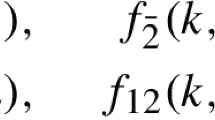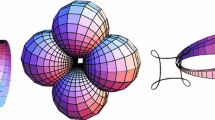Abstract
We explore a specific discretization of isothermic nets in the plane which can also be interpreted as a discrete holomorphic map. The discrete orthogonality of the quadrilateral net is achieved by the so called conical condition imposed on vertex stars. That is, the sums of opposite angles between edges around all vertices are equal. This conical condition makes it possible to define a family of underlying circle patterns for which we can show invariance under Möbius transformations. Furthermore, we use the underlying circle pattern to characterize discrete isothermic nets in the projective model of Möbius geometry, and as Moutard nets in homogeneous coordinates in relation to the light cone in this model. We further investigate some examples of discrete isothermic nets and apply the Christoffel dual construction to obtain discrete minimal surfaces of conical type.












Similar content being viewed by others
References
Bobenko, A.I., Hoffmann, T., Springborn, B.A.: Minimal surfaces from circle patterns: geometry from combinatorics. Ann. Math. (2) 164(1), 231–264 (2006)
Bobenko, A.I., Pinkall, U.: Discrete isothermic surfaces. J. Reine Angew. Math. 475, 187–208 (1996)
Bobenko, A.I., Suris, Yu.B.: Discrete differential geometry: integrable structure. In: No. 98 in Graduate Studies in Math. American Math. Soc., USA (2008)
Bobenko, A.I., Suris, YuB: Discrete Koenigs nets and discrete isothermic surfaces. Int. Math. Res. Not. IMRN 11, 1976–2012 (2009)
Cecil, T.E.: Lie sphere geometry. Universitext, 2nd edn. Springer, New York (2008)
Christoffel, E.B.: Ueber einige allgemeine Eigenschaften der Minimumsflächen. J. Reine Angew. Math. 67, 218–228 (1867)
Darboux, G.: Leçons sur la théorie générale des surfaces et les applications géométriques du calcul infinitésimal. Deuxième partie. Chelsea Publishing Co., Bronx (1972)
Doliwa, A.: Geometric discretization of the Koenigs nets. J. Math. Phys. 44(5), 2234–2249 (2003)
He, Z.X., Schramm, O.: On the convergence of circle packings to the Riemann map. Invent. Math. 125(2), 285–305 (1996)
Henrici, P.: Applied and computational complex analysis. In: Wiley Classics Library, vol. 1–3. Wiley, New York (1993)
Hertrich-Jeromin, U.: Introduction to Möbius differential geometry. In: London Mathematical Society Lecture Note Series, vol. 300. Cambridge University Press, Cambridge (2003)
Liu, Y., Pottmann, H., Wallner, J., Yang, Y.L., Wang, W.: Geometric modeling with conical meshes and developable surfaces. Proc. SIGGRAPH. ACM Trans. Graph. 25(3), 681–689 (2006)
Müller, C.: Conformal hexagonal meshes. Geom. Dedicata 154, 27–46 (2011)
Müller, C.: Discretizations of the hyperbolic cosine. Beitr. Algebra Geom. 54(2), 509–531 (2013)
Müller, C., Wallner, J.: Semi-discrete isothermic surfaces. Results Math. 63(3–4), 1395–1407 (2013)
Pottmann, H., Liu, Y.: Discrete surfaces in isotropic geometry. In: IMA Conference on the Mathematics of Surfaces, Lecture Notes in Computer Science, vol. 4647, pp. 341–363. Springer, Berlin (2007)
Pottmann, H., Wallner, J.: The focal geometry of circular and conical meshes. Adv. Comput. Math. 29(3), 249–268 (2008)
Richter-Gebert, J.: Perspectives on Projective Geometry. Springer, Heidelberg (2011)
Rodin, B., Sullivan, D.: The convergence of circle packings to the Riemann mapping. J. Differ. Geom. 26(2), 349–360 (1987)
Sauer, R.: Differenzengeometrie. Springer, Berlin (1970)
Stephenson, K.: Introduction to Circle Packing. Cambridge University Press, Cambridge (2005)
Wang, W., Wallner, J., Liu, Y.: An angle criterion for conical mesh vertices. J. Geom. Graph. 11(2), 199–208 (2007)
Wunderlich, W.: Beitrag zur Kenntnis der Minimalschraubflächen. Compositio Math. 10, 297–311 (1952)
Acknowledgments
This research was supported in part by the DFG Collaborative Research Center TRR 109, ‘Discretization in Geometry and Dynamics’ through Grant I 706-N26 of the Austrian Science Fund (FWF).
Author information
Authors and Affiliations
Corresponding author
Appendix
Appendix
In the appendix we give a proof of Proposition 2 with methods from classical projective geometry. We split up the proof into the following lemmas. For further details on projective geometry see e.g. the textbook [18].
Lemma 6
Let \(\kappa :\mathbb {P}^2\rightarrow \mathbb {P}^2\) be a collineation in the real projective plane \(\mathbb {P}^2\), and let g denote a straight line. Furthermore, let us denote the point of intersection of the line g and \(\kappa (g)\) by s (see Fig. 13 left). Then the conic c that is tangent to all lines \(a \vee \kappa (a)\) for all \(a\in g\) (J. Steiner’s definition of line-conics) touches both lines g and \(\kappa (g)\) at \(\kappa ^{-1}(s)\) and \(\kappa (s)\), respectively.
Proof
g and \(\kappa (g)\) are in the set of lines tangent to c. Let us assume c touches g in a point t different from \(\kappa ^{-1}(s)\). According to our definition of c the straight line h connecting t and \(\kappa (t) \ne s\) is a tangent of c. However, it is impossible to have two different tangents g and h both going through t. The proof for \(\kappa (s)\) being a contact point works analogously. \(\square \)
Lemma 7
Let \(f, f_i, f_{ij}, f_j\in \mathbb {P}^2\) be four points and let further \(S_1, S_2\) be orientation preserving similarities defined by (for notation cf. Sect. 1.3 and Fig. 13 center)
Furthermore, let
Then there is a conic c tangent
Proof
There is a conic c constructed with Lemma 6 for the collineation \(\kappa = S_1\) and for \(g = f \vee f_i\). Consequently, by construction (6) is fulfilled and the four connecting lines from (6) and (7) are tangent to c. Since \(S_1\) is a similarity one tangent of c is the line at infinity. Consequently, c is the unique parabola tangent to the four lines from (6) and (7). Analogously, \(S_2\) produces a parabola fulfilling (7) and having the same four tangents as c. Therefore the second conic is identically equal to c. \(\square \)
Lemma 8
We take the same assumptions and notations as in Lemma 7. Then the four lines
all pass through a common point z. For an Illustration see Fig. 13 (center).
Proof
We apply Brianchon’s theorem (see e.g., [18, Th. 10.7]) two times.
First, we consider the two line elements (i.e., tangent plus contact point) \(t_{12} = (f_j\vee f_{ij}, f_j^-)\), \(t_{45} = (f_i\vee f_{ij}, f_i^+)\) and the two tangents \(t_3 = f\vee f_j\) and \(t_6 = f\vee f_i\). Brianchon’s theorem stays true if we replace two different tangents by one line element. That is, two tangents \(t_1, t_2\) can be replaced by one line element \((t_{12}, T)\) where \(t_1 \cap t_2\) then corresponds to the contact point T. Brianchon’s theorem now implies that the three lines
pass through a common point z. Analogously, for the two line elements \(t_{12} = (f\vee f_{i}, f_{-j}^-)\), \(t_{45} = (f\vee f_{j}, f_{-i}^+)\) and the two tangents \(t_3 = f_i\vee f_{ij}\) and \(t_6 = f_j\vee f_{ij}\) we obtain, by applying Brianchon’s theorem, that the three lines
pass through a common point \({\tilde{z}}\). However, z and \({\tilde{z}}\) is the same point since both lines \(f_i\vee f_j\) and \(f^+ \vee f^-\) are in both sets of lines. \(\square \)
Now we have collected all the properties we need to prove Proposition 2.
Proof of Proposition 2
By applying Pascals theorem (see e.g., [18, Th. 10.6]) we show the existence of a conic passing through \(p_1 = f_{-i}^+\), \(p_2 = f^+\), \(p_3 = f_{i}^+\), \(p_4 = f_{j}^-\), \(p_5 = f^-\), \(p_6 = f_{-j}^-\). Lemma 8 implies that the three points
are collinear (see Fig. 13 right). Consequently, Pascal’s theorem implies that the six points \(p_1, \ldots , p_6\) lie on a conic. \(\square \)
Rights and permissions
About this article
Cite this article
Müller, C. Planar discrete isothermic nets of conical type. Beitr Algebra Geom 57, 459–482 (2016). https://doi.org/10.1007/s13366-015-0256-4
Received:
Accepted:
Published:
Issue Date:
DOI: https://doi.org/10.1007/s13366-015-0256-4





